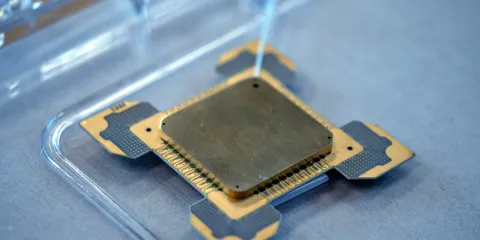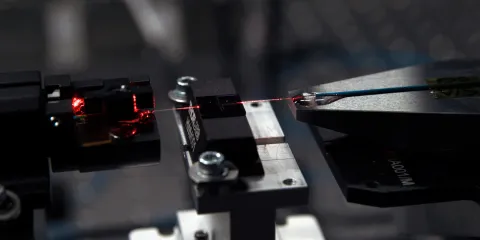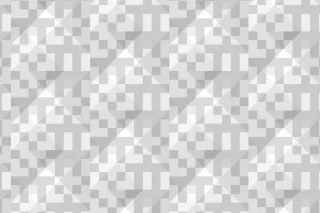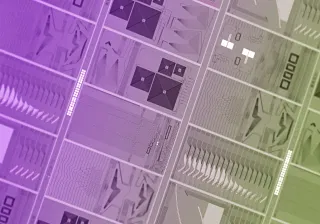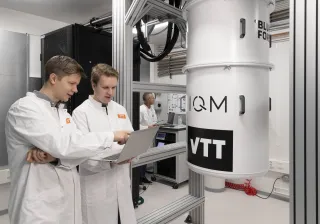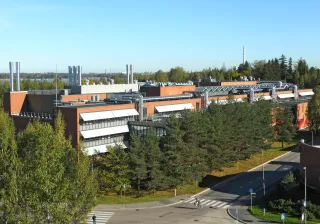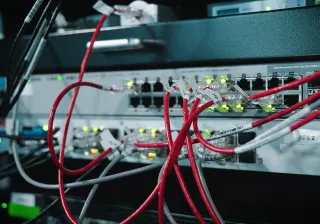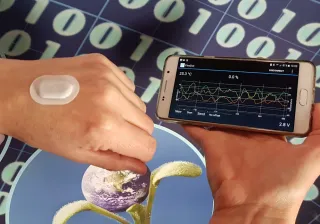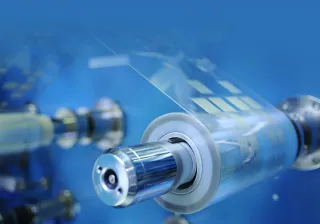2D materials and graphene

Graphene and other 2D materials can provide new extraordinary functionalities in electronics, photonics and sensing applications. Pioneered by graphene, this new class of single-layer materials is rapidly progressing from research towards industrial adaptation.
We offer:
Graphene R&D services for sensing, photonics and electronics with in-house processing with high yield also on 200 mm CMOS wafers
Wafer-scale CVD graphene and 2D semiconductors on rigid and flexible substrates
Combining the 2D materials with SoA application knowledge and ASIC design in sensing, edge and quantum computing, photonics and RF electronics

Why 2D materials and graphene?
Only one-atom thick graphene is world's thinnest material – but it is also strong, light, and flexible. Graphene’s exceptional qualities allow a range of applications in next generation technologies. From healthcare to energy and communications to aeronautics, graphene and other graphene-based materials open up completely new opportunities for different industry domains.
The demand for graphene is forecast to grow in the coming years as demand for applications in new areas like energy storage, semiconductors, and sensors continue to grow. The size of the global graphene market is estimated to grow at the annual rate of almost 40 percent from 2020 to 2027.
VTT as a 2D material and graphene innovation partner
At VTT, we have been working with 2D material science and graphene related research projects for over a decade. We innovate and develop new graphene related components and processes for different application domains. We collaborate with the leading graphene providers and complementary metal–oxide–semiconductor (CMOS) foundries and operate in a class 10–100 clean room with full micro- and nanofabrication, and characterization facilities.
VTT is part of the EU funded 2D-Experimental Pilot Line (2D-EPL) established to bring the graphene and 2D semiconductor processing and process integration to meet the standards of semiconductor industry. VTT is also part of the Graphene Flagship, a European Union research initiative set to bring graphene innovation out of the lab and into commercial applications.
Our services in 2D materials and graphene include:
- Research and development – including for example custom CMOS design and post processing as well as graphene and 2D semiconductor integration
- Confidential contract research
- Material and device characterization
- Custom CMOS design and post-processing
- Graphene and 2D semiconductor integration
- MPW runs
- Small to medium volume manufacturing
VTT is also working in the 2D material standardisation in collaboration with the Graphene Flagship’s Standardization committee and International Electrotechnical Commission (IEC) to enhance the industrial maturity.
We combine graphene devices into systems
At VTT we also conduct research related to low-loss silicon photonics, superconducting and semiconducting quantum technology as well as sensors, MEMS and micromodules. Graphene and other 2D material-based devices can be integrated with all these technologies, for example as modulators and detectors for telecom and sensing applications in integrated photonics.
We develop systems including IC readouts for multiplexed graphene sensors and full neuromorphic systems with integrated novel edge computing and in-logic memory devices. We are with you through the full development cycle, all the way from innovation to design, process optimization, system integration as well as small scale manufacturing.
Graphene biosensors
Graphene biosensors can be used in various applications such as medical diagnostics, environmental surveys, food quality control and research. The most typical graphene-based biosensors rely either on field effect or surface plasmon polariton based sensing. Field effect based biosensing offers interesting possibilities with label-free sensing possibilities that enables much cheaper sensors when compared to the more traditional optical sensing methods. When compared to the other field effect based biosensing materials such as carbon nanotubes and silicon nanowires graphene offers clear benefits in easier fabrication and higher yield of the devices.
VTT’s standard graphene biosensor process is optimized for field effect transistor type liquid gated sensors, with resistive and capacitive readout on monolithically integrated CMOS. The fabrication process relies on bottom contacts and passivated electrodes, leaving only the active graphene surface and Pt electrodes open for functionalization. The typical process yields on CMOS integrated multiplexed sensors on 200 mm wafers is above 95%, and the passivation has been tested to survive most functionalization protocols even with several days of exposure.

VTT Printed Intelligence makes it possible to create products that have never been seen before: flexible, lightweight organic solar cells, illuminating surfaces, sensors integrated directly on skin and communicating labels for packaging.
Our standard biosensor structure and process can be modified and developed to meet the requirements of various custom biosensors. By adding a custom ASIC readout as well as readout electronics, the biosensor can be integrated to a portable system. At VTT, we can also offer services related to - biofunctionalization - and bioanalysis with graphene coated SPR and QCM chips.
2D materials for flexible applications
Graphene and 2D semiconductors can also be applied on flexible substrates and VTT has developed processes that allow device fabrication on flexible platforms with low thermal budget. The 2D materials provide a unique combination of high frequency devices based on graphene, and 2D semiconductor-based logic with reasonably high mobility for example for TFT matrices.
Some of the applications of 2D materials developed at VTT include:
- CVD graphene micro- and nano processing on various polymer sheets
- releasable thin films
- encapsulation processes to preserve high mobility
- solutions for readout integration
By contacting our experts on this page, you’ll get more detailed examples of our 2D material and graphene projects and applications. As an alternative approach, VTT’s facilities for Printed Intelligence and expertise on solution processed graphene for electrodes and conductors on polymers, fabrics and paper allow novel metal-free large-area applications in a scalable and sustainable way. You will find more information about these applications from our printed electronics service page.
Should you be interested in further details on 2D material science or applications, don’t hesitate to get in touch with our experts. We’ll get you started with single-layer materials and support your graphene innovation and commercialisation journey.
Downloads
- Download our 2D materials and graphene brochure
